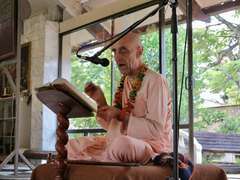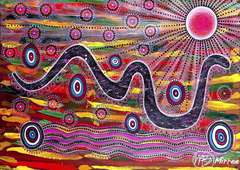Dear Hanumatpresak Swami Maharaja,
Thank you for your kind reply to my post on your blog.
HpS - AGTSP!!! paoho. Thank you for your patience in dealing with this buffalo-headed teacher of a Punjabi student.
Yes, our daughters are turning into young women fast. Family life is a great service opportunity for us.
And, yes, for sure I have lost my mind. Totally mad… he he
ASA - Foto attached.
Please allow me to share some passages from “Aboriginal Spirituality: Aboriginal Philosophy The Basis of Aboriginal Social and Emotional Wellbeing”, by Indigenous Australian philosopher, Vicky Greives.
Page 8: ...Many non-Aboriginal writers and some Aboriginal people have recorded these creation stories from different parts of the country over time. These stories are often characterised as the Dreaming and, as with Spirituality, the English words are not equivalent to the meaning that exists in Aboriginal languages for the basis of the philosophy, and for the Spirituality that is encompassed within it.
Baldwin Spencer and F. J. Gillen, a late nineteenth-century anthropologist and an ethnographer respectively, translated the Arrernte words altijira ngambakala as ‘dreaming’, and altjira rama as meaning ‘to dream’ (Spencer & Gillen 1899). The linguist T. G. H. Strehlow, who grew up the son of missionaries among Arrernte at Hermannsburg in Central Australia in the early twentieth century, noted that the word altjira also means ‘eternal’, and so the idea of dreaming also includes the ‘seeing’ of eternal things during sleep. Thus, the more accurate translation would be ‘originating from eternity’ (Stockton 1995:54).
Page 11: ....Further, it would be wrong to characterise the Dreaming as a wholly past event: it is everywhen; that is, in ‘all the instants of being, whether completed or to come’ (Stanner 1979:23–4). It can be characterised as an underlining reality, and the term Dreaming is often used to stand for Aboriginal peoples’ ‘experience and knowledge of the manifestations and the secrets of Divinity’ (Stanner 1979:28). Although this can be construed as two co-existent realities—that is, ordinary and dream realities—Sansom (2001) argues that there is ‘a single supervening reality that has “inside” and “outside” truths and stories and, therefore, ‘Dreamings and people are co-presences in one world, treating knowledge as the great discriminating and modifying force’ (Sansom 2001:2–3). Although humans cannot hope to grasp the full knowledge of truths that are embedded in the Dreaming, they have the opportunity to develop as visionaries, that is, as clever men and women who have a privileged understanding and can see right through, their vision penetrating all the way to the inside.
However, this idea of knowledge ‘allows each person the opportunity to live a life of progressive revelations’ and ‘anyone who lives a fortunate life should come to participate more and more fully in the unity of the Dreaming’ (Sansom 2001:2–3), without being necessarily a person of great insight. In fact, sudden and unasked for revelations of the power of the Dreaming can occur, something anthropologists call irruptions, and these are met with joy, manifest as laughter in the cases Sansom reports (Sansom 2001:2–3).
“Altjira Rama” sounds a lot like entrance into samadhi to me...
Ajita Rama?!?!
Ys
Dhruva
Paper available for free download here: https://www.lowitja.org.au/page/services/resources/Cultural-and-social-determinants/mental-health/Aboriginal-Spirituality-Aboriginal-Philosophy
HpS - I think we deal with these states that may be describe in Patanjali's terms as Samadhi etc, more as different states of Smaranam: https://vedabase.io/en/library/noi/8/#bb6004
Also, the different aspects of Bhava that are described in the Southern part of the NoD, no?
Can we join together from different religious traditions and enter into deeper states of consciousness?
Make a great change in the world?


